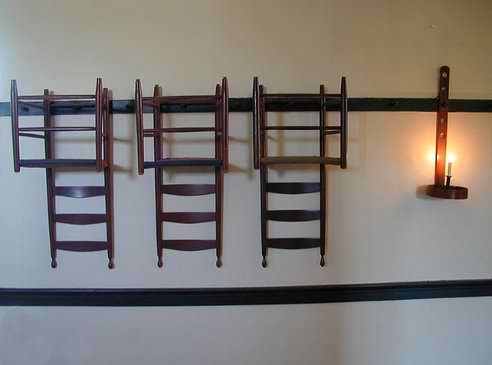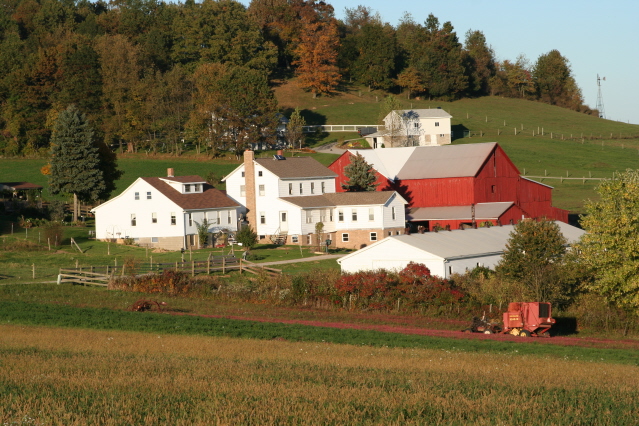Shaker Style Furniture Made by the Amish
Submitted by Amish Valley Pr... on Tue, 09/25/2012 - 7:50am
Shaker Style Furniture as Made by the Amish in Ohio
By Mike DeHaan
“Shaker furniture” is now made by Amish furniture manufacturers as well as number of other small and large cabinet firms.
Who were the Shakers? What were their guiding principles in developing their distinctive furniture designs? What features should we look for in Shaker furniture? How well do the Amish follow the Shakers’ lead in manufacturing this style of furniture?
The Origins of the Shakers
The “Shakers” became an offshoot of the Quakers, or “Friends”, in Britain in the middle 1700s.
Quaker worship services had traditionally been quiet…nay, silent…until someone was moved to speak briefly. In contrast, Shakers worshipped more demonstrably, with dancing or spinning, shaking, and speaking in tongues. Shakers did maintain the Quaker pacifist position, however.
The first leaders of the Shakers were James and Jane Wardley. At first, the main distinction for this denomination was simply the style of worship. Their contemporaries might have been surprised that Jane Wardley fulfilled a role in preaching sermons.
About a decade after its origin, another charismatic leader, “Mother” Ann Lee, came along to further define the doctrines and practices. Some sixteen years after joining the Shakers, she led eight followers to establish colonies in the New World, specifically what is now New York State. This was in 1774, just before the American War of Independence. Her preaching in New England attracted several thousand converts. Due to their strict practice of celibacy, their communities only grew through “immigration” rather than by childbirth.
As a side note: Ann Lee’s insistence on celibacy may have resulted from her grief at the deaths of her four children while they were still quite young.
Early Shaker communities farmed and became rather self-sufficient; although the same might be said for many of their contemporary settlements in New England. They lived in dormitories, and shared their possessions as community property. Their early leaders further developed the patterns for the Shaker lifestyle.
The Quakers remain a small but viable Christian denomination through the present time. However, perhaps only one Shaker community survives today: Maine’s Sabbathday Lake Shaker Village (at http://www.shaker.lib.me.us/about.html ).
Shaker Ingenuity and Shaker Furniture
The Shakers have earned a reputation for ingenuity by minimizing the use of raw materials in functional and practical inventions. One example is the circular saw.
The Shakers lived to glorify God, to be worthy of heaven, and to benefit both their own community and the world at large. Their belief in denying selfish desires led to the refusal to patent their inventions or to keep their furniture designs private. They tried to work towards perfection in every manner, including their work habits.
Shaker furniture was designed to be sturdy but light-weight. Consider that a Shaker worship service might begin with people seated in a rustic parlour; but soon the attendees would stand, shake, and then whirl or dance about. Someone would have to rack the chairs onto pegs on the walls, just to make room for the heightened activity. Later the chairs would come down at mealtime.

Thus the traditional Shaker chair is solid wood with three light-weight slats at the back. This combined longevity with ease of use: completely practical for its intended purpose.
Simplicity of style continues with Shaker bedroom or dining furniture.
Amish Valley Products Jewelry Armoire
However, as the picture of the armoire shows, practicality and functionality can lead to significant detail and complexity. The side doors and different sizes of drawer make this piece appear more complex than one might expect in a “simple” design. However, this unit is very functional; and so the practical requirement drives the design.
Shaker style furniture has no fancy scrollwork or carvings.
The wood might be preserved with stains or with white paint.
Modern Manufacturing of Shaker Furniture
While the Shakers certainly designed and built the furniture that bears their name, other firms began manufacturing articles in the Shaker style as it grew in popularity.
Now the Shaker settlements have almost all died out, and the Sabbathday community makes “fancy goods…(and) some small woodenware” rather than furniture.
Therefore any new furniture in the Shaker style is manufactured by other firms.
How Compatible are the Amish and Shaker Lifestyles?
The Amish may be best suited to carry on manufacturing furniture in the traditional Shaker style. They have some similarities in their history, outlook and lifestyle; although they would be quick to point out their differences as well.
First, the Amish had immigrated to North America due to religious persecution several centuries ago. They had split from an earlier “Anabaptist” denomination, the Mennonites, around 1700.
The Amish live in their own homes but these form communities, organized around their local worship services and family farms. Although they come from an Anabaptist faith heritage, which is distinct from the Quakers, the Amish are also a self-sufficient culture with a lifestyle different from most North Americans. (One point of difference is that the Amish do not practice celibacy. They do indeed marry, one husband with one wife, and are very likely to have several children).
The Amish and Shakers share religious beliefs favouring non-violence and pacifism; both would honour God by their hard work and faithful lifestyles.
Can the Amish do Justice to Shaker Furniture?
After immigrating to North America, the Amish settled into farming communities. Sometime in the twentieth century, the Amish began turning to small manufacturing to supplement their incomes or to provide work for their family members. Part of the reason is that the price of farmland increased, and it became more difficult to buy more land for all the sons.

An Ohio Amish Farm
The Amish use relatively small workshops, which would rarely have more than a dozen workers. For the most part, they use hand tools or small power tools that run on electricity from their own diesel generators. (This practice is important to their Christian faith: they remain “separate from the world” although they live and do some business in it).
Most of the pieces are made to order, since their sales are mostly through local or national retailers.
The Amish have learned to manufacture furniture in several styles, mainly linked through attributes such as solid wood construction, simplicity of design and strict attention to detail and quality. For example, the Amish have become masters of both the Mission style and also of Shaker style furniture.
The Amish dedication to handcrafted quality, as well as their background in small rural communities, have served them well in carrying forward the heritage of Shaker furniture.
Further Reading about the Shakers and Shaker Furniture
Shaker furniture is a very popular style; and the Shakers themselves have a fascinating history.
“Shaker” at http://www.britannica.com/EBchecked/topic/537839/Shaker briefly introduces the history and beliefs of the “United Society of Believers in Christ’s Second Appearing”.
“Shaker Furniture” at http://www.britannica.com/EBchecked/topic/537846/Shaker-furniture is also an example of brevity.
“Shaker Furniture is Practical Christianity in Wood Furniture” at http://suite101.com/article/shaker-furniture-is-practical-christianity-i... covers similar ground.




